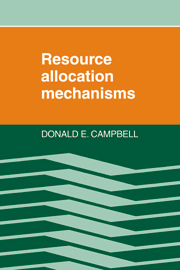Book contents
- Frontmatter
- Contents
- Preface
- Chapter 1 Introduction
- Chapter 2 Performance criteria
- Chapter 3 The Arrow–Debreu world
- Chapter 4 Uncertainty
- Chapter 5 Incentive compatibility
- Chapter 6 Existence of a competitive equilibrium
- Chapter 7 Welfare properties of the Walrasian mechanism
- Appendix 1 Elements of consumer choice
- Appendix 2 The Edgeworth exchange economy
- Appendix 3 Proof of the Shafer–Sonnenschein theorem
- References
- Author index
- Subject index
Appendix 3 - Proof of the Shafer–Sonnenschein theorem
Published online by Cambridge University Press: 05 June 2012
- Frontmatter
- Contents
- Preface
- Chapter 1 Introduction
- Chapter 2 Performance criteria
- Chapter 3 The Arrow–Debreu world
- Chapter 4 Uncertainty
- Chapter 5 Incentive compatibility
- Chapter 6 Existence of a competitive equilibrium
- Chapter 7 Welfare properties of the Walrasian mechanism
- Appendix 1 Elements of consumer choice
- Appendix 2 The Edgeworth exchange economy
- Appendix 3 Proof of the Shafer–Sonnenschein theorem
- References
- Author index
- Subject index
Summary
The existence theorem proved in Shafer and Sonnenschein (1975) relies on a weaker convexity assumption than condition (6.8), namely, quasi-convexity: Pa is quasiconvex if for all m ∈ M the convex hull of Pa(m) does not contain ma. (A convex combination of members of a set A is any weighted average of a finite number of points in A such that the weights are nonnegative and sum to unity. The convex hull of A, denoted CH(A), is the set of all convex combinations of members of A.) Note that quasicon vexity is implied by conditions (6.8) and (6.9).
Theorem A.7. Suppose that M is a nonempty, convex, closed, and bounded subset of some finite-dimensional Euclidean space [conditions (6.3) and (6.4)]. If, for each a = 1, 2, …, N, Pais quasiconvex and has an open graph [condition (6.7)] and Ba is a continuous [condition (6.5)] and convex-valued [condition (6.6)] correspondence, then there exists some m ∈ M such that ma ∈ Ba(m) and Ba(m) ∩ Pa(m) = ∅, a = 1, 2, …, N.
Proof: For any agent a and any let
The set is closed since Pa has an open graph. Therefore, Ua is well defined. Also, is nonnegative and strictly positive if and only if.
- Type
- Chapter
- Information
- Resource Allocation Mechanisms , pp. 170 - 171Publisher: Cambridge University PressPrint publication year: 1987



